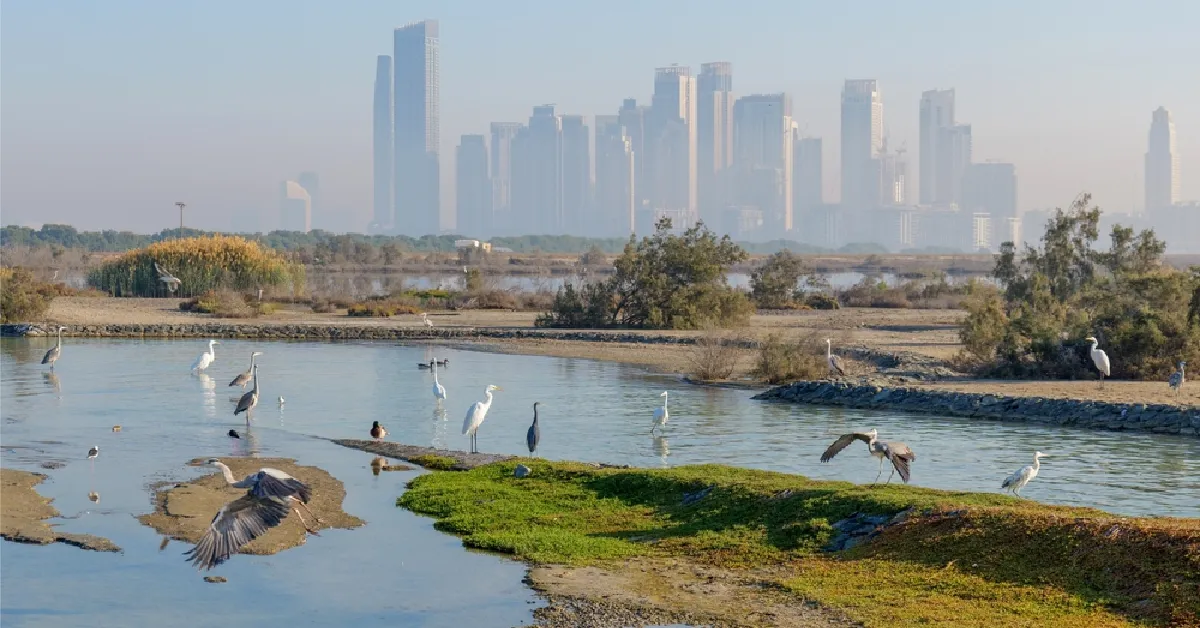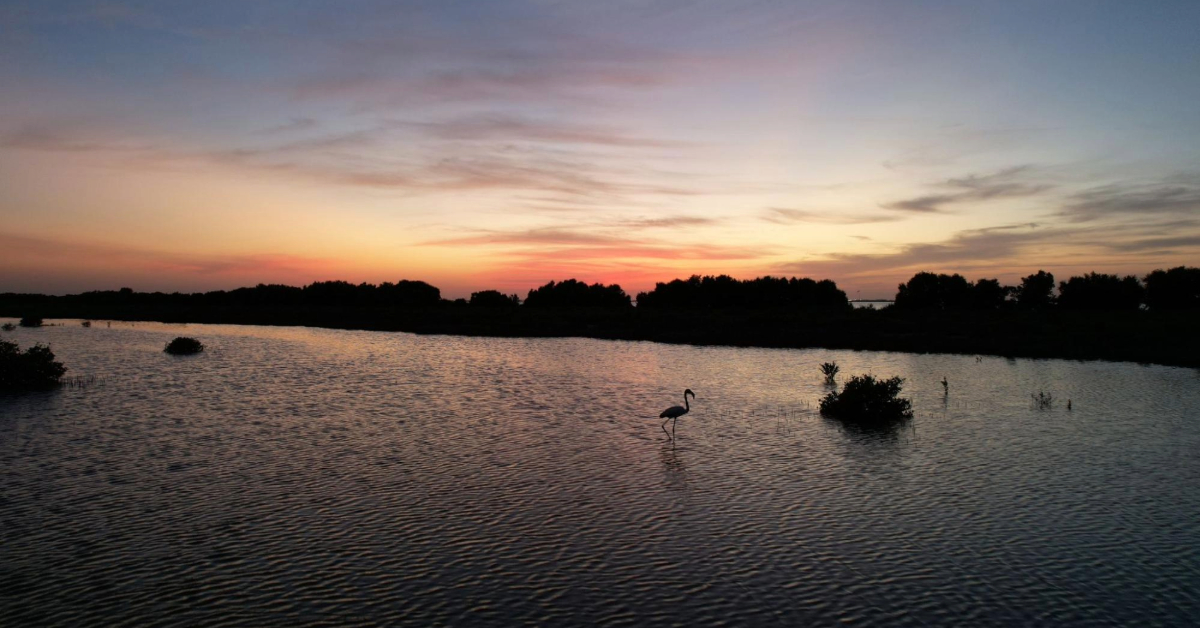Khor Al Beidah in Umm Al Quwain is one of the UAE’s most breathtaking natural reserves. A stretch of mangroves, tidal creeks, and mudflats, it’s alive with flamingos, herons, fiddler crabs, and schools of fish. For anyone who craves raw beauty and calm away from the city, this is the spot. Families, birdwatchers, and eco-tourists often call it one of the UAE’s best-kept secrets.
The best part? It’s free to enter. In less than an hour from Dubai, you can be standing on mudflats watching flamingos take flight.
Thinking of living closer to escapes like this? Explore Umm Al Quwain communities and see what’s available.
To help you explore this guide, here’s what we’ll cover:
- Where is Khor Al Beidah located?
- History and traditional use
- Ecological importance
- Wildlife you can spot
- Activities to enjoy at Khor Al Beidah
- Seasonal guide: when to visit
- Facilities and nearby amenities
- Educational and research value
- Day trip itinerary suggestion
- Sustainability and conservation
- Visitor experiences and stories
- Comparisons with other UAE reserves
- Travel tips for tourists
- Tips for visiting Khor Al Beidah
- Real estate connection: living near nature
- Local dining guide
- Behind the scenes at Khor Al Beidah
- Key takeaways
- FAQs
Where is Khor Al Beidah located?
The reserve lies on the northern coast of Umm Al Quwain. It’s about 55 km from Dubai and just 25 km from Sharjah — perfect for a short trip. Driving is the easiest option, and navigation apps like Google Maps and Waze will guide you directly. As you approach, the scenery shifts from desert highways to lush mangroves and calm tidal waters.
Nearby landmarks include the UAQ Marine Club, Barracuda Beach Resort, and Palma Beach Resort, all of which offer excellent dining options or provide a great location to extend your trip.
History and traditional use
Khor Al Beidah has been part of Umm Al Quwain’s heritage for centuries. Historically, local fishermen and traders relied on its waters. Wooden dhows anchored in the calm lagoon, unloading fresh fish for markets and families. The mangroves offered natural protection for boats, while also providing wood for fuel and tools.
Pearl diving also shaped the area. Divers sailed from the khor during the pearling season, bringing back shells that held treasures and supported the local economy. Marine life was more than just food; it was a culture that shaped songs, stories, and the very livelihoods of its inhabitants.
Today, while fishing boats are fewer, the reserve still carries echoes of that heritage. A stroll along the mudflats feels like stepping back into a time when life revolved around the sea.
Ecological importance

Khor Al Beidah is vital to the UAE’s ecosystem. The mangroves act as carbon sinks, absorbing greenhouse gases. They shield the coast from erosion and storms, while also serving as nurseries for young fish, shrimp, and crabs.
Migratory birds from Europe, Asia, and Africa stop here to rest and feed. Without this wetland, many would struggle to survive their long journeys.
Wildlife you can spot
The reserve is alive with wildlife. Bring binoculars — you’ll spot:
- Greater flamingos: huge flocks feeding in shallow waters.
- Grey and western reef herons: graceful hunters along the banks.
- Kentish plovers and terns: small but fascinating shorebirds.
- Ospreys: powerful raptors diving for fish.
- Kingfishers: darting quickly across the water.
- Waders and sandpipers: probing the mud for food.
Beyond birds, the mudflats teem with fiddler crabs waving claws, mudskippers hopping across puddles, and tiny fish swimming in tidal pools. Children are always fascinated by these small creatures.
Winter is the best season. Thousands of migratory birds transform the reserve into a spectacular sight. At sunrise, the skies light up as flocks of flamingos take flight together.
Activities to enjoy at Khor Al Beidah

There’s plenty to do here:
- Birdwatching: The main attraction. Early mornings and evenings bring the best views.
- Kayaking: Paddle through mangrove channels. Eco-tour operators in UAQ rent kayaks for guided trips.
- Photography: The combination of blue water, green mangroves, and pink flamingos creates stunning photos. Sunrise and sunset are breathtaking.
- Family outings: Safe and open, great for children to explore.
- Eco-tours: Guided tours help visitors understand the delicate balance of this ecosystem.
Seasonal guide: when to visit
- Winter (Nov–Mar): Best season. Cool weather, large bird populations, and breathtaking sunsets.
- Spring (Apr–May): Still pleasant, fewer crowds, suitable for families.
- Summer (Jun–Aug): Hot and humid. Visit at dawn if you go.
- Autumn (Sep–Oct): Migratory birds start returning, and the weather begins to cool.
Facilities and nearby amenities
Inside the reserve, facilities are minimal. There are no cafés, toilets, or shops. Visitors must plan. Bring snacks, water, sunscreen, and hats. A cooler bag helps keep drinks cold, especially in summer.
Nearby, Umm Al Quwain offers plenty of options:
- Barracuda Beach Resort: Family-friendly with restaurants and a pool.
- Palma Beach Resort & Spa: Meals with sea views.
- UAQ Marine Club: Water sports and activities.
- Guesthouses in UAQ town: Affordable alternatives for overnight stays.
Combining a morning in the reserve with lunch at a resort and an afternoon by the beach makes for a balanced trip.
Educational and research value
Khor Al Beidah isn’t just for tourists. It’s also a living classroom. Schools bring students here to learn about wetlands, biodiversity, and the importance of conservation. Universities use it as a field site for research on bird migration, mangrove ecosystems, and climate change.
Researchers often study how mangroves capture carbon, how fish populations rely on tidal systems, and how migratory birds depend on this stopover. For many, it’s a real-world laboratory that combines science, culture, and sustainability.
Day trip itinerary suggestion
Plan your day like this:
- 7:00 a.m.: Arrive for sunrise and flamingo watching.
- 9:00 a.m.: Join a kayak eco-tour through the mangroves.
- 12:00 p.m.: Lunch at Barracuda Resort or a local seafood restaurant.
- 2:00 p.m.: Relax at Palma Beach Resort or visit Dreamland Aqua Park with kids.
- 5:00 p.m.: Stroll along UAQ’s quiet beaches.
- 7:00 p.m.: Head back to Dubai or Sharjah.
Sustainability and conservation
Khor Al Beidah is fragile. Authorities limit fishing and restrict access to protect habitats. Visitors also play a role: avoid plastic, use reusable bottles, and never disturb nesting birds. Even simple steps, such as staying on paths, help preserve this ecosystem.
The reserve aligns with the UAE’s eco-tourism objectives, ensuring that wetlands like this thrive for future generations.
Visitor experiences and stories
Visitors often describe the reserve as unforgettable. Families recall children fascinated by fiddler crabs. Photographers love how every trip feels like a new adventure.
Teachers say it’s one of the best outdoor classrooms, with students amazed to see wildlife so close. Eco-tourists highlight how quiet and undisturbed it feels compared to other reserves.
Comparisons with other UAE reserves
- Ras Al Khor (Dubai): Popular but busier, with observation hides.
- Khor Kalba (Sharjah): Home to rare species like the Arabian collared kingfisher.
- Jubail Mangrove Park (Abu Dhabi): Offers boardwalks and modern visitor facilities.
- Khor Al Beidah (UAQ): Raw, quiet, and authentic.
Each has its strengths, but for peace and authenticity, Khor Al Beidah is unmatched.
Travel tips for tourists
- Transport: Car is best. Taxis from UAQ town are also available.
- Packing: Bring water, hats, sunscreen, binoculars, and snacks.
- Clothing: Light, breathable clothes in summer; a jacket in winter mornings.
- Costs: Entry is free. Kayak tours typically range from AED 100 to 200 per person.
- Safety: Mudflats can be slippery. Wear sturdy shoes and supervise children.
- Photography: DSLR or telephoto lenses recommended for birdwatching shots.
- Eco-rules: No littering, no disturbing wildlife, and avoid drones unless permitted.
Tips for visiting Khor Al Beidah
- Arrive early for sunrise views.
- Bring your own supplies — no shops inside.
- Wear sturdy shoes for walking on mudflats.
- Keep children close to the water.
- Don’t disturb nesting birds or leave rubbish.
Real estate connection: living near nature
Love the idea of being close to nature? Umm Al Quwain offers a slower pace of life than Dubai or Sharjah. Communities near Khor Al Beidah give you peace, greenery, and wildlife at your doorstep.
Check Umm Al Quwain listings on Property Finder. Use Data Guru to compare property prices, or explore the Price Map for an overview.
Ready to make the move? Contact a SuperAgent in UAQ for local expertise.
Local dining guide
After a morning exploring Khor Al Beidah, you’ll probably be ready for a good meal. Umm Al Quwain is famous for its seafood, with restaurants serving freshly caught fish and prawns cooked in traditional Emirati and regional styles.
Some popular spots include:
- Al Jurf restaurants: small family-run eateries where you can try grilled fish with rice.
- Barracuda Resort dining: offering seafood buffets and international options.
- Palma Beach Resort restaurants: known for outdoor dining with sea views.
- Local cafeterias in UAQ town: perfect for quick bites and affordable meals.
Emirati favourites, such as machboos (spiced rice with fish) and harees (a wheat and meat porridge), are often featured on the menu. For those who prefer international cuisine, many resorts also serve continental and Asian dishes.
Behind the scenes at Khor Al Beidah
Arrive at dawn, and you’ll see the reserve at its most lively. The tide is low, revealing mudflats crawling with crabs. Fishermen prepare their boats in the distance, while eco-guides set up kayaks for the first tours of the day.
As the sun rises, the mangroves glow golden and flocks of flamingos stretch their wings. The air fills with bird calls, and photographers line up their shots. By mid-morning, families arrive with binoculars and snacks, ready to enjoy a relaxed outing.
Evenings bring a different charm. The setting sun casts long shadows across the water, and the reserve grows quieter. It’s the perfect time for a peaceful stroll or some last photographs before heading into town for dinner.
Key takeaways
The protected wetlands in Khor Al Beidah, Umm Al Quwain, are one of the UAE’s hidden natural gems, just under an hour’s drive from Dubai. Entry is free, making it an accessible escape for families, photographers, and eco-tourists seeking a peaceful day in the natural world. The area is especially famous for its flamingos, herons, and lush mangroves, offering incredible birdwatching and photography opportunities. The wetlands are best enjoyed during winter or early mornings when the wildlife is most active. Facilities are limited, so visitors are encouraged to come prepared and self-sufficient, ensuring a comfortable experience while preserving the pristine environment.
FAQs
Flamingos, mangroves, and quiet scenery.
Yes, there’s no charge.
Drive from Dubai (55 km) or Sharjah (25 km).
No shops or cafés. Bring your own supplies.
Yes, eco-tour operators in UAQ offer rentals.
Definitely. Kids love spotting crabs and birds.
Yes, Barracuda and Palma Beach Resorts serve meals.
Winter (Nov–Mar) for cooler weather and bird migrations.
Yes, but wear suitable shoes.
Yes, UAQ resorts and hotels are nearby.
Yes, free parking is close to the reserve.
Yes, but paths can be uneven.
No, it’s not a swimming zone.
Yes, eco-tours and kayak trips are common.
Rarely — it’s quieter than other UAE reserves.
Some areas may be closed to protect nesting birds.
Yes, guided photo tours are sometimes organised.
Only with permits, as they may disturb birds.
Pets are not recommended, as they may disturb wildlife.
Occasionally, guided night walks are offered to observe nocturnal species.